Facing Chanco’s dearest slum
Chikanda, like any other slum, symbolises the laxity of town planners universities keep churning out. Our staff writer JAMES CHAVULA writes.
When University of Malawi (Unima) opened a new campus in Zomba in 1973, two bushy ridges—Chikanda and Chirunga—lay side by side. Between them a stream flowed in no apparent haste.
Forty two years on, Chikanda is a densely populated settlement with no discernible planning.
Its dwellers, pushed too close to the colonial capital’s sewage treatment plant, could be getting a raw deal from Chancellor College (Chanco) where some geography students major in town and country planning.
They say the college learners and workers usually cross the stream, a dumpsite for the slum dwellers, to rent cheap homes and gulp local distils.
“Some come to drink and sleep, while others impregnate our daughters,” said a Chikanda resident.
On the other side, academics accuse their neighbours of wiping out trees and building houses in Chirunga Forest near the immaculate campus, which has some elements of physical planning.
In the department of geography and earth science, Chikanda offers physical planning learners numerous lessons of what not to do when they graduate.
“Chanco wants to be part of the solution,” says human geography lecturer Grace Yambeni. “We want to become a university in the park by maintaining the green areas no matter how big the campus grows.”
A sharp contrast
But the shanty residential area puts into question the coexistence of what Professor David Rubadiri—a revered poet and former Unima vice-chancellor—termed “towns and gowns”.
Leadership for Environment and Development (Lead) director Professor Sostein Chiotha puts the eyesore in context: “Is it not a contradiction that Chanco is well-planned, a centre of excellence in physical planning, but Chikanda in its vicinity is in a mess? This is a shocking contrast, isn’t it?”
The environmentalist, who campaigns for resilient settlements, is one of the lead researchers in Africity Project—a German-funded initiative promoting Zomba resident’s right to a just, inclusive and resilient city where their wellbeing and participation are guaranteed.
Like Rubadiri, he expects universities to help solve problems affecting their neighbourhoods and the rest of the population.
To Yambeni, this is a “depressing contrast” a mark of uneasy co-existence with encroachers from the clustered settlement.
“We are debating whether to fence the campus. Should we close the college from Chikanda where we get cheap labour and affordable housing? No. We opted to leave it open while we are consulting,” she said.
Zomba City Council (Zacc) chief executive officer Dyson Jangiya wants the dons and their students to step forward and join the urban agenda by helping duty-bearers and planners understand and solve prevailing challenges.
“It is ironic that we have experts and chaos in our midst. Chanco has to contribute to the planning of the city, even offering free consultancies,” he said. According to Jangiya, Chikanda is one of the areas controlled by Malawi Housing Corporation (MHC).
“This makes it difficult for the council to enforce by-laws,” he explained.
Old-timers say the number of squatters in Chikanda has surged since the early 1980s. The population mostly comprises people migrating from rural areas in search of jobs and business openings.
“We need to put beacons on vacant places. We need to plan for 50 years. Unfortunately, we are still planning for tomorrow,” bemoaned Jangiya.
Slums confirm lack of foresight, planning and law enforcement as public universities—especially Chanco, The Polytechnic and Mzuzu University (Mzuni)—keep training physical planners.
Persistent headache
According to Mzuni-based physical planning specialist Mtafu Zeleza Manda, high urbanisation rates and laxity in ensuring no one settles in unplanned and disaster-prone areas have left cities messy and vulnerable to disasters.
He was speaking when torrential rains killed seven and displaced thousands in Mzuzu last year.
Zacc director of physical planning Fred Nankhuyu described a “persistent headache” to councils, MHC and Department of Lands.
“On paper, customary land does not exist in all cities. On the ground, we have chiefs who distribute land and refuse to shift unless we compensate them,” he lamented.
The council cannot afford compensation and resettlement payouts for thousands occupying unplanned settlements in urban areas, he said.
“This is urbanisation of poverty as those migrating from rural areas become poorer,” he explained.
Nowhere to go
Nationwide, cities are under pressure to provide habitable land for almost 2.5 million slum dwellers.
Censuses shows the population of the 39km2 colonial city has shot from just 19 000 in 1960 to 156 000.
Councils in Zomba, Blantyre, Lilongwe and Mzuzu want to extend city boundaries, but Nankhuyu says this will be no sustainable solution.
“The city is running out of space,” he warned. “We may grow to Liwonde, but the city will still be chaotic unless we change the way we build. We must start constructing high-rise buildings to use available land prudently.”





